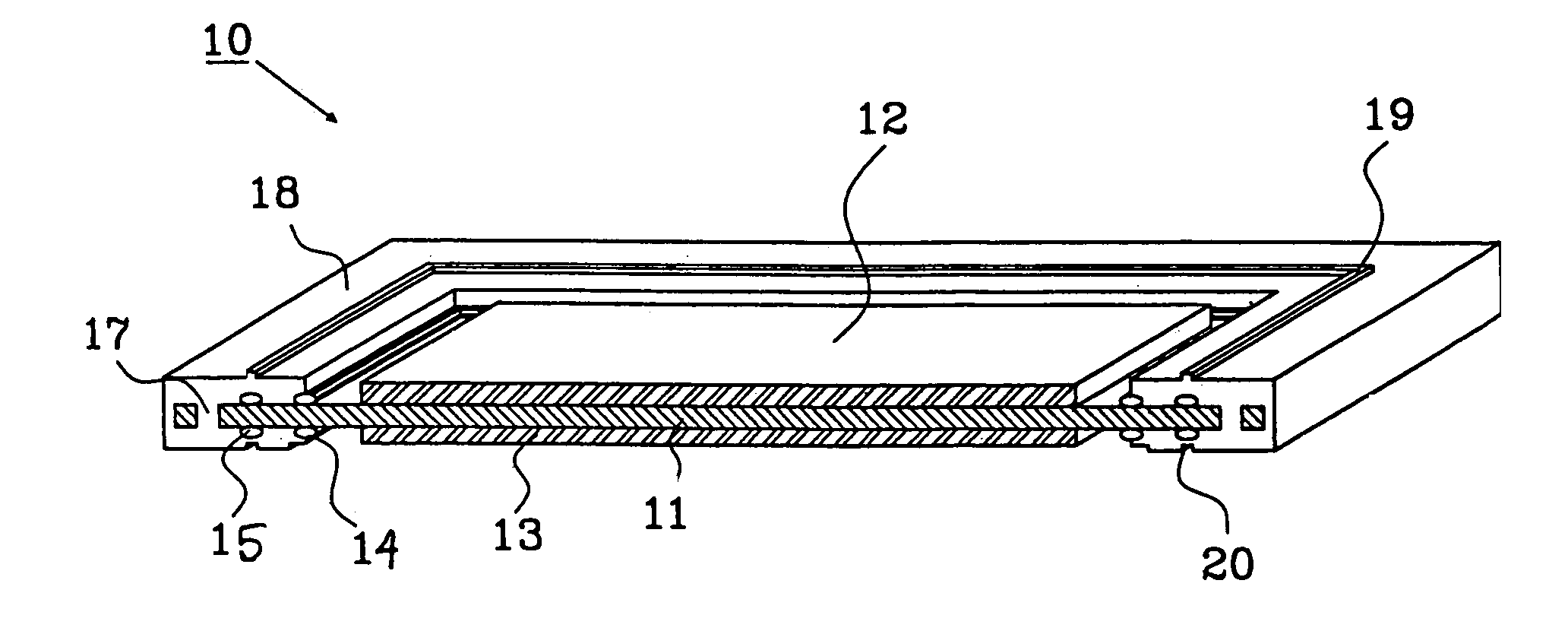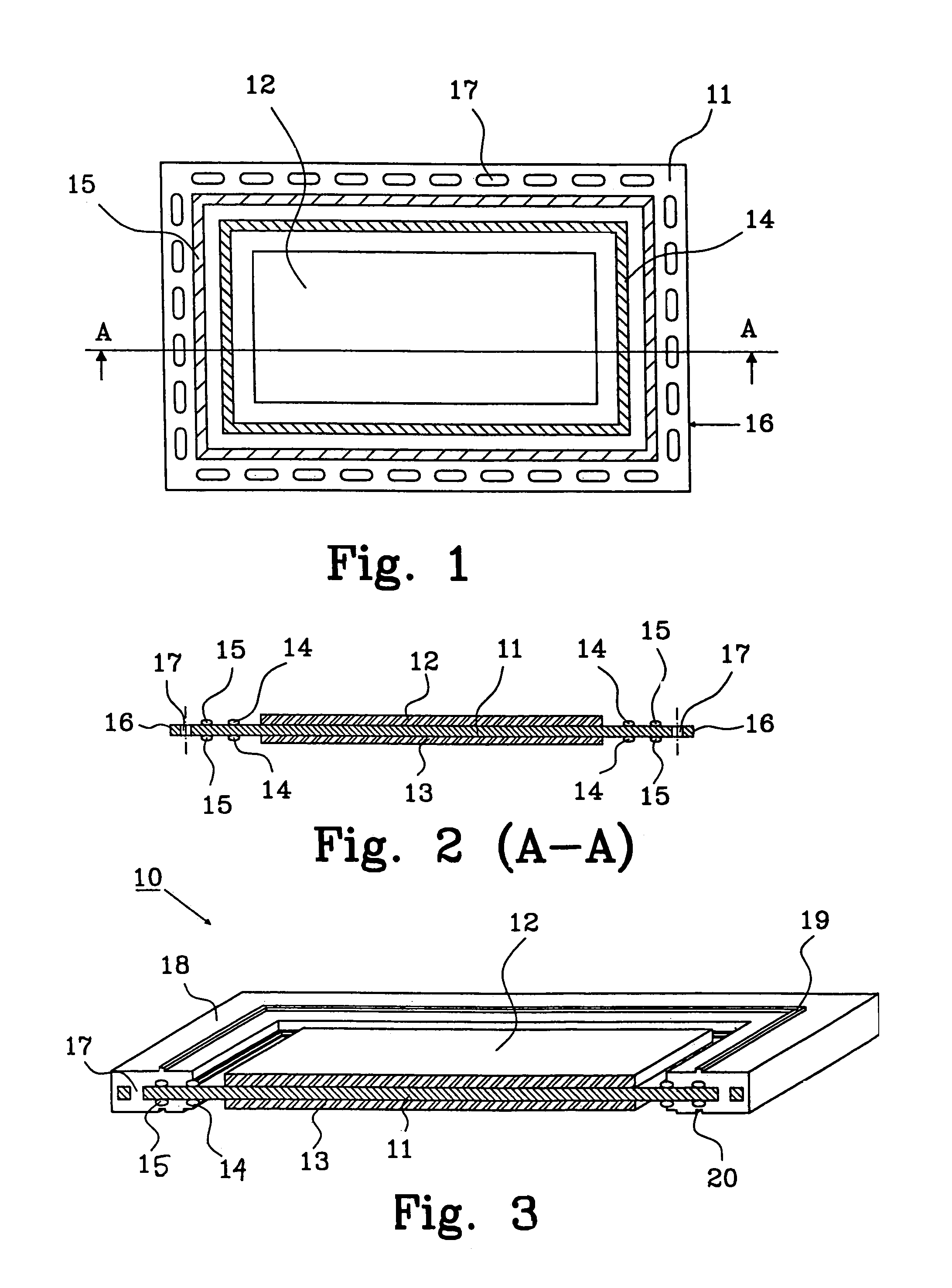Bipolar battery and biplate assembly
a bi-polar battery and assembly technology, applied in the field of bi-polar batteries, can solve the problems of rechargeable batteries, and difficult to achieve the proper combination of these characteristics, so as to prevent electrolyte leakage paths, improve heat conductive properties, and improve sealability
- Summary
- Abstract
- Description
- Claims
- Application Information
AI Technical Summary
Benefits of technology
Problems solved by technology
Method used
Image
Examples
first embodiment
[0043]FIG. 1 is a planar view and FIG. 2 is a cross sectional view (along A—A in FIG. 1) of a biplate assembly. Normally a biplate assembly requires a frame to make up the individual cells within the battery, but for the sake of clarity the frame is omitted in FIGS. 1 and 2.
[0044]The biplate assembly comprises a biplate 11, preferably made from Nickel or Nickel plated steel. A positive electrode 12 and a negative electrode 13 are attached to each side, respectively, of the biplate 11. Each electrode is arranged to cover only a central portion of the side of the biplate 11 to leave space for implementing the sealing and heat conducting means. A hydrophobic barrier 14, which prevents formation of an electrolyte path between cells, is provided on both sides of the biplate between the electrode and an elastomer 15. The elastomer 15 prevents gas leakage from the cell together with the frame (not shown). The elastomer is provided between the barrier 14 and the edge 16 on both sides of the...
second embodiment
[0055]FIG. 4 is a planar view and FIG. 5 is a cross sectional view (along A—A in FIG. 4) of a biplate assembly, where the frame is omitted for the sake of clarity.
[0056]The biplate assembly comprises a biplate 21, preferably made from Nickel or Nickel plated steel. A positive electrode 12 and a negative electrode 13 are attached to each side, respectively, of the biplate 21. Each electrode is arranged to cover only a central portion of the side of the biplate 21 as described in connection with FIGS. 1 and 2. An electrolyte barrier 22 is provided on both sides of the biplate between the electrode and an elastomer 23, which is provided between the electrolyte barrier 14 and the edge 16 on both sides of the biplate 21.
[0057]In this embodiment no holes are provided around the perimeter of the biplate 21. The ring of elastomer 23 is in this embodiment made wider, thereby achieving an even better seal to prevent gas leakage due to the elastic properties of the elastomer 23, as will come m...
third embodiment
[0060]FIG. 7 shows a cross-sectional view of a part of a complete biplate assembly 40, including a frame 41. The frame encompass only the ring of elastomer 23 on both sides of the biplate 21. The frame 41 also has guiding means 19, 20 as described above, with tapered surfaces 42 and 43 provided on each side of the tongue 19. The advantage with this arrangement is the same as described in connection with FIG. 6.
[0061]It is essential that the frame encompass the ring of elastomer to prevent gas leakage from one cell to another. The electrolyte barrier, preventing electrolyte leakage, will function the same irrespectively if the frame partly encompass it or not.
[0062]FIGS. 8a–8f illustrates a manufacturing process in cross section for a bipolar battery according to the invention.
[0063]A biplate 21 is provided in FIG. 8a, which has a predetermined size. The size may vary depending on the intended application.
[0064]FIG. 8b illustrates the appearance after the steps of providing an electr...
PUM
| Property | Measurement | Unit |
|---|---|---|
| Hydrophobicity | aaaaa | aaaaa |
Abstract
Description
Claims
Application Information
 Login to View More
Login to View More - R&D
- Intellectual Property
- Life Sciences
- Materials
- Tech Scout
- Unparalleled Data Quality
- Higher Quality Content
- 60% Fewer Hallucinations
Browse by: Latest US Patents, China's latest patents, Technical Efficacy Thesaurus, Application Domain, Technology Topic, Popular Technical Reports.
© 2025 PatSnap. All rights reserved.Legal|Privacy policy|Modern Slavery Act Transparency Statement|Sitemap|About US| Contact US: help@patsnap.com



